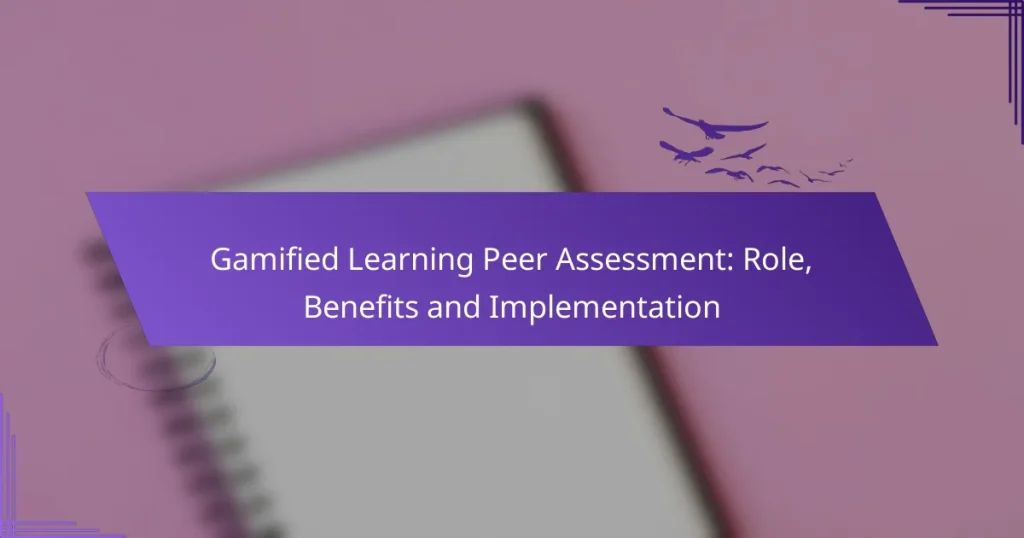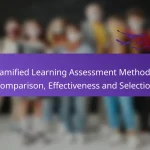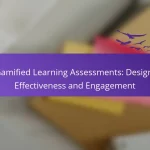Gamified learning peer assessment merges game mechanics with peer evaluation to boost student engagement and improve learning outcomes. By encouraging participants to assess each other’s work within a structured, often competitive framework, this approach fosters critical thinking and collaboration while motivating learners to provide meaningful feedback.
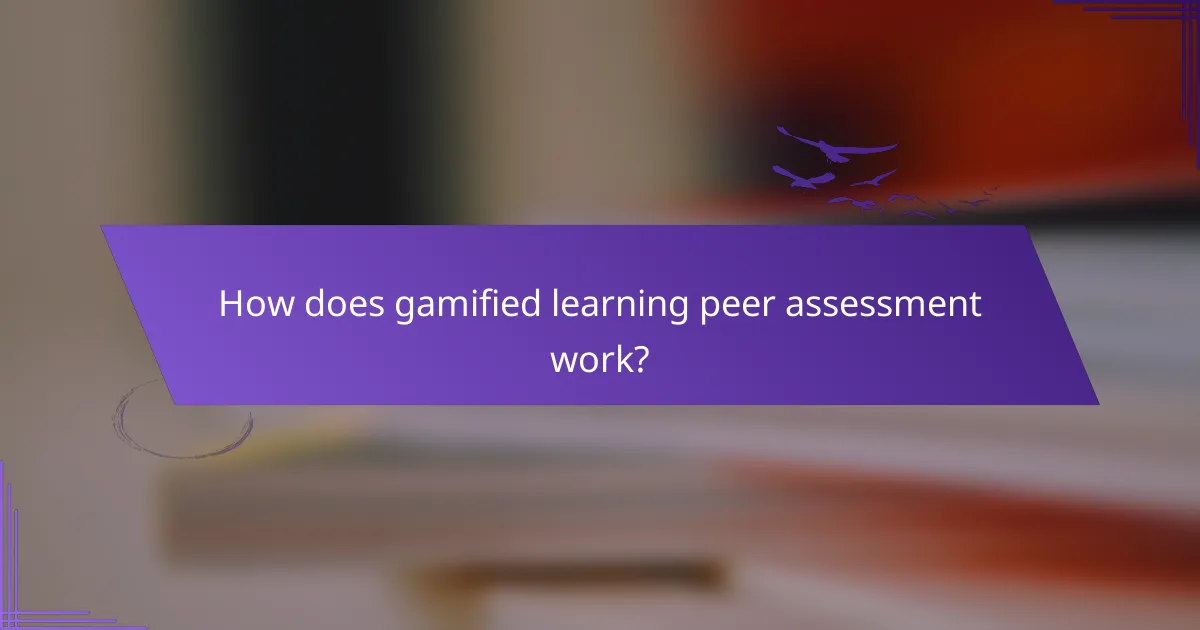
How does gamified learning peer assessment work?
Gamified learning peer assessment combines game elements with peer evaluation to enhance engagement and learning outcomes. Participants assess each other’s work using structured criteria, often within a competitive or collaborative framework, which motivates them to provide constructive feedback.
Interactive feedback mechanisms
Interactive feedback mechanisms are essential in gamified peer assessment, allowing learners to engage actively with the material and each other. These can include features like comment sections, rating systems, or even real-time discussions, enabling participants to provide immediate and contextual feedback.
For example, platforms may use visual indicators such as progress bars or badges to show how much feedback has been given or received. This not only encourages participation but also fosters a sense of community among learners.
Scoring and ranking systems
Scoring and ranking systems are integral to gamified peer assessment, as they introduce an element of competition that can drive motivation. Participants may earn points for providing feedback, completing assessments, or achieving certain milestones, which can be displayed on leaderboards.
These systems should be designed carefully to ensure fairness and transparency. For instance, consider weighting scores based on the quality of feedback rather than just quantity, which can help maintain high standards in peer evaluations.
Peer review processes
Peer review processes in gamified learning involve structured guidelines that participants follow when assessing each other’s work. This can include rubrics that outline specific criteria for evaluation, ensuring that feedback is constructive and relevant.
To implement an effective peer review process, establish clear expectations and provide training on how to give and receive feedback. Regularly revisiting these processes can help refine them and address any issues that arise, ensuring a positive learning experience for all participants.
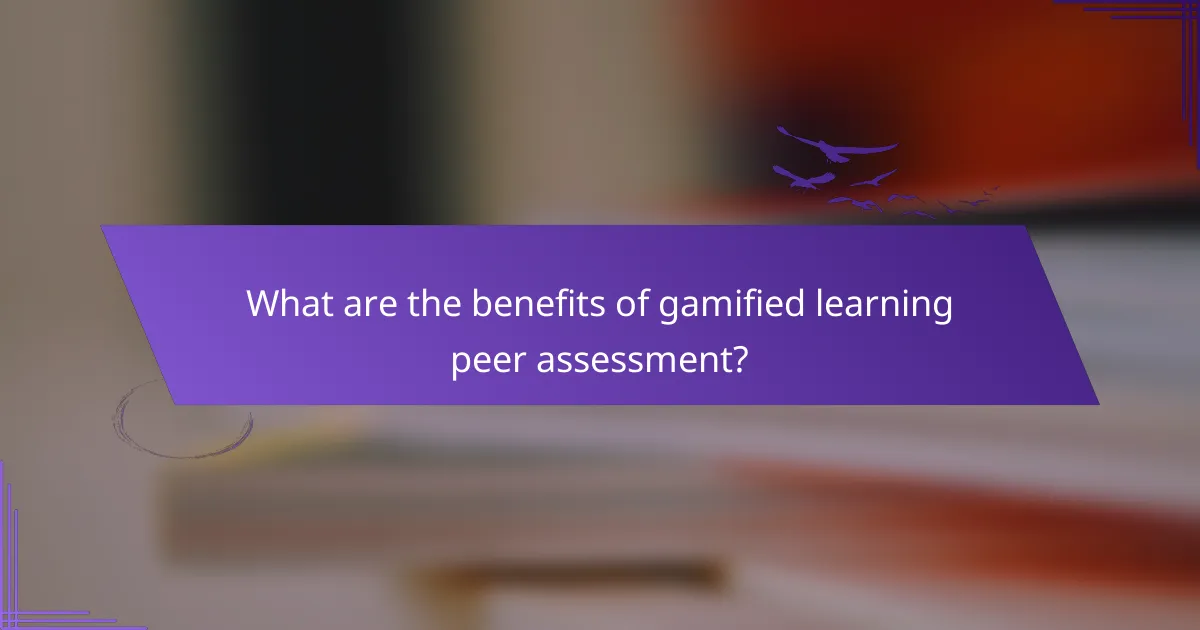
What are the benefits of gamified learning peer assessment?
Gamified learning peer assessment offers several advantages, including increased engagement, enhanced critical thinking, and improved collaboration among learners. By integrating game elements into the assessment process, students are more likely to participate actively and benefit from diverse perspectives.
Enhanced engagement and motivation
Gamified learning peer assessment significantly boosts student engagement and motivation. When assessments incorporate game-like elements, such as points, badges, or leaderboards, learners are more inclined to participate and invest effort in their work.
For example, a peer assessment platform that rewards students with points for providing constructive feedback can create a competitive yet supportive environment. This approach encourages learners to actively contribute and enhances their overall learning experience.
Improved critical thinking skills
Engaging in peer assessment through gamification fosters critical thinking skills among learners. By evaluating their peers’ work, students must analyze, synthesize, and apply their knowledge, which deepens their understanding of the subject matter.
Additionally, providing feedback requires learners to articulate their thoughts clearly, promoting clarity and coherence in their reasoning. This process not only benefits the assessors but also helps the recipients of feedback improve their work based on constructive criticism.
Fostering collaboration among learners
Gamified peer assessment encourages collaboration by creating opportunities for students to work together. When learners assess each other’s work, they engage in discussions that promote knowledge sharing and collective problem-solving.
For instance, incorporating team-based assessments where groups compete for rewards can strengthen relationships among peers. This collaborative approach not only enhances learning outcomes but also builds a sense of community within the classroom.

How can online courses implement gamified peer assessment?
Online courses can implement gamified peer assessment by incorporating game elements into the evaluation process, encouraging engagement and motivation among learners. This approach not only enhances the learning experience but also fosters collaboration and constructive feedback among peers.
Choosing the right platform (e.g., Moodle, Canvas)
Selecting the appropriate platform is crucial for effective gamified peer assessment. Platforms like Moodle and Canvas offer built-in tools for creating assessments, tracking progress, and facilitating peer reviews. Consider factors such as user interface, ease of integration, and available gamification features when making your choice.
For example, Moodle provides a variety of plugins that can enhance gamification, while Canvas has a user-friendly design that simplifies the assessment process. Evaluate your course needs and the technical capabilities of each platform to find the best fit.
Designing assessment criteria
Clear and transparent assessment criteria are essential for successful peer evaluation. Define specific learning outcomes and expectations that align with course objectives. This clarity helps students understand what is required and how their contributions will be assessed.
Consider using rubrics that outline performance levels for different criteria. This not only standardizes evaluations but also provides students with constructive feedback on their work. Aim for criteria that are measurable and achievable, ensuring they encourage meaningful peer interactions.
Integrating game mechanics
Incorporating game mechanics can significantly enhance the engagement level of peer assessments. Elements such as points, badges, and leaderboards can motivate students to participate actively and provide high-quality feedback. For instance, awarding points for completing assessments or giving constructive feedback can create a competitive yet collaborative environment.
Additionally, consider implementing time-limited assessments or challenges to increase urgency and excitement. However, ensure that these mechanics do not overwhelm students; balance is key to maintaining a positive learning experience.

What challenges might arise during implementation?
Implementing gamified learning peer assessment can present several challenges that may hinder its effectiveness. Key issues include technical difficulties, resistance from learners, and ensuring fairness in assessments.
Technical difficulties
Technical difficulties can arise from inadequate infrastructure or software compatibility issues. For instance, if the chosen platform does not support the required features, it may lead to frustration among users.
To mitigate these challenges, ensure that the technology used is user-friendly and well-supported. Conducting a pilot test can help identify potential problems before full-scale implementation.
Resistance from learners
Resistance from learners is a common challenge, as some may be skeptical about the effectiveness of peer assessments. They might feel uncomfortable providing feedback or worry about the accuracy of their evaluations.
To address this, provide clear guidelines and training on how to assess peers constructively. Encouraging a culture of collaboration and emphasizing the benefits of peer feedback can also help reduce resistance.
Ensuring fairness in assessments
Ensuring fairness in assessments is crucial for maintaining trust in the peer evaluation process. Bias or favoritism can skew results, leading to inaccurate assessments.
Implementing anonymous feedback mechanisms can help alleviate concerns about bias. Additionally, providing rubrics that outline clear criteria for evaluation can standardize assessments and promote fairness among learners.

What are best practices for effective peer assessment?
Effective peer assessment relies on clear communication, structured guidelines, and ongoing training. These practices ensure that participants understand their roles and responsibilities, leading to more meaningful evaluations.
Providing clear guidelines
Clear guidelines are essential for effective peer assessment as they set expectations for both assessors and those being assessed. These guidelines should outline the criteria for evaluation, the process to follow, and the timeline for submissions.
Consider using a rubric that details specific performance indicators. This helps participants focus on key aspects of the work, making it easier to provide constructive feedback. For example, a rubric might include categories such as clarity, creativity, and adherence to guidelines.
Training participants
Training participants on how to conduct peer assessments is crucial for ensuring quality feedback. This can include workshops or online tutorials that explain the assessment process, the importance of constructive criticism, and how to use the provided guidelines effectively.
Encourage practice assessments where participants can evaluate sample work before engaging in actual peer reviews. This not only builds confidence but also helps them understand the nuances of effective assessment.
Regularly updating assessment criteria
Regularly updating assessment criteria keeps the peer assessment process relevant and effective. As learning objectives evolve, so should the criteria used for evaluation. This ensures that assessments align with current educational goals and standards.
Gather feedback from participants on the assessment process to identify areas for improvement. Consider conducting reviews at the end of each assessment cycle to refine criteria based on practical experiences and outcomes.
